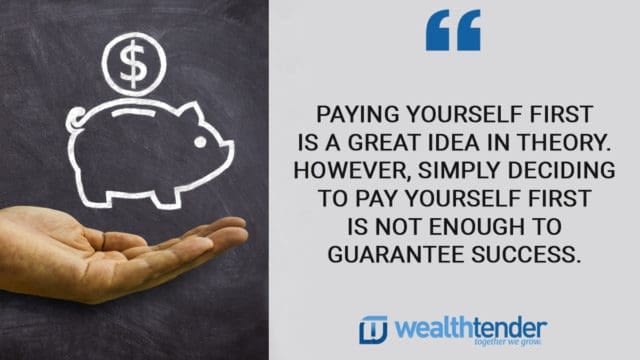To make Wealthtender free for readers, we earn money from advertisers, including financial professionals and firms that pay to be featured. This creates a conflict of interest when we favor their promotion over others. Read our editorial policy and terms of service to learn more. Wealthtender is not a client of these financial services providers.
➡️ Find a Local Advisor | 🎯 Find a Specialist Advisor

The Automatic Millionaire by David Bach was one of the first personal finance books I ever read. It’s a fairly easy read with some very practical lessons. The book has three major concepts that are still very relevant nearly 14 years after it’s initial release.
- Pay yourself first
- Put it on automatic
- The “latte factor”
Pay yourself first
The concept of paying yourself first is just as it sounds. Each payday, the first thing you do is set aside money for saving and investing. Before you pay any bills, including your rent, you decide how much money you can spare to put towards your financial goals and you make that your number one priority.
Let’s say you wanted to save 10% of your take-home pay for retirement. If you clear ,500 per paycheck after taxes, the first thing you would do is put $150 into your retirement account.
Paying yourself first is a particularly effective strategy for people who don’t have a budget. In an ideal world, everyone would have a budget that is reflective of their goals and values. In reality, most people don’t have a budget. They choose to “wing it” when it comes to money and then wonder why they haven’t reached their goals.
If you don’t want to stick to a budget, paying yourself first guarantees you a baseline level of savings. If your monthly take-home pay is $3,000 and you pay yourself 10% of your income first, you’ll be saving $300 per month. You may not have a plan for the other $2,700 but at least you’re building some savings.
Paying yourself first applies to more than just retirement savings. If you want to get out of debt you can also “pay yourself first” by dedicating a certain amount of money to the principal of your debt.
Instead of dedicating the $300 per month towards retirement, you might choose to pay an extra $300 towards your credit card debt.

Put it on Automatic
Paying yourself first is a great idea in theory. However, simply deciding to pay yourself first is not enough to guarantee success. There is a behavioral issue that needs to be addressed. As humans, we often have great intentions when it comes to budgeting, diets and saving plans but we are rarely able to stick with it for the long term. Every new year we make a resolution to lose weight and save more and every February we end give up on our diet and start racking up credit card debt.
That is where the concept of automation comes into play. This is the central concept of the book and why it’s called “The Automatic Millionaire”.
Most banks allow you to easily set up an automated withdrawal from your checking account on every pay-day and have that money placed into a savings or investment account. By doing this you are taking the concept of paying yourself first and automate the process. This has two major benefits.
- It takes the decision out of your hands
- You don’t even miss the money
Returning to our previous example of deciding to pay yourself $300 per month before you make any other financial decisions. If you got paid on the 1st and 15th of every month, you would simply set up an automatic withdrawal of $150 from your checking account to a savings account on the 1st and 15th.
The money is never in your checking account long enough for you to spend. After a while, you adjust your spending as if that money was never there. Think about the taxes that come off your paycheck every two weeks, most people don’t even notice because the process is automated.
The “latte factor”
This is both the most controversial and still-relevant concept from the book. The idea behind the latte factor is that seemingly small and routine purchases like buying a latte can add up to large sums over time. Bach argues that by cutting out these small purchases and automating the savings towards saving and investing, you can generate much more wealth over your lifetime.
Other well-known personalities have pushed this same concept. Most notably Suze Orman has shamed Millennials for “pissing $1 million down the drain”. She is referring to some back of the envelope calculation showing the opportunity cost of buying a $5 coffee every day instead of investing. These comments sparked a backlash and the coining of a new phrase, “Coffee shaming”.
I am split on the concept of the latte factor. On the one hand, it’s true if you cut back on these indulgences and redirected that money towards savings you would build more wealth over your lifetime. On the other hand, personal finance should be a life choice, not a life sentence.
If your financial plan is making you miserable, odds are you won’t stick to it. I do think it’s a good idea to try going a week or even a month where you cut all non-essential spending. Doing so will give you clarity on the things you miss and the things you don’t. From there, continue spending (a reasonable amount) on the things you miss and cut out the things you don’t.
The more money you spend on things you value and the less you spend on “stuff”. the happier you are likely to be.

Pulling it all together
If we are to apply the three concepts from The Automatic Millionaire we can hit our financial goals more effortlessly. Here are a few steps we can take, using these concepts to change our relationship with money.
Step 1: create your financial goals.
- When do you want to retire?
- When would you like to be out of debt?
- Do you want to build an emergency fund?
Step 2: work out how much you need to save each month to achieve these goals.
- How much do you need to save to retire by 65?
- How do you make sure you are out of debt in 5 years?
- How do you build a 3-month emergency fund over the next two years?
Step 3: Automate monthly savings you figured out in step 2.
Step 4: Stop spending money on “stuff” you don’t value.
Step 5: Start spending money on things you do value.
That is the simplest explanation I can make on how to manage your money. While it is simple, it’s not easy. It is something I will be working with my students on in my money management course.
Related Articles from our Network
📚 The Best Books for Productivity (Partners in FIRE)

About the Author
Ben Le Fort
In the eight years following graduation, he paid off all of the debt and built a seven-figure net worth. Ben holds a Bachelor’s degree in economics from Acadia University and a Master’s degree in Economics & Finance from The University of Guelph.
Ben lives in Waterloo, Ontario, with his wife, son, and cat named Trixie.
To make Wealthtender free for readers, we earn money from advertisers, including financial professionals and firms that pay to be featured. This creates a conflict of interest when we favor their promotion over others. Read our editorial policy and terms of service to learn more. Wealthtender is not a client of these financial services providers.
➡️ Find a Local Advisor | 🎯 Find a Specialist Advisor
